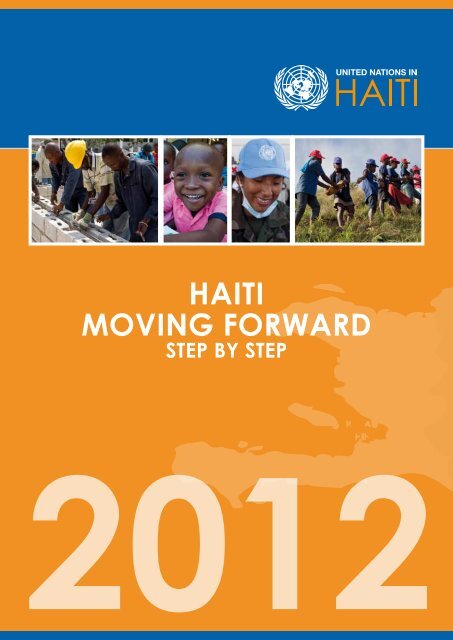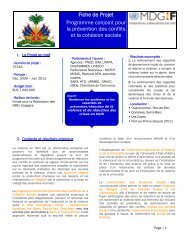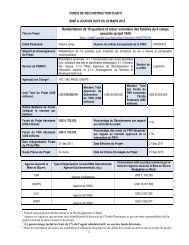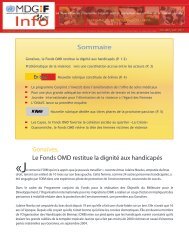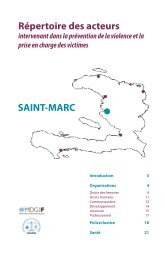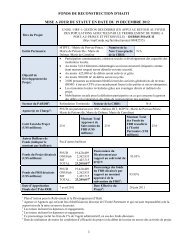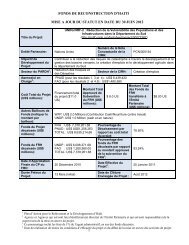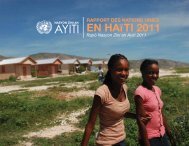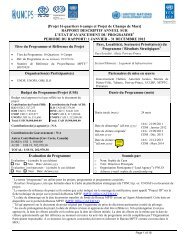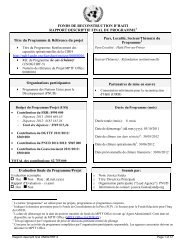HAITI MOVING FORWARD - ONU en Haiti
HAITI MOVING FORWARD - ONU en Haiti
HAITI MOVING FORWARD - ONU en Haiti
Create successful ePaper yourself
Turn your PDF publications into a flip-book with our unique Google optimized e-Paper software.
prefaceMARIANO FERNáNDEZ AmunáteguiSpecial Repres<strong>en</strong>tative of the Secretary-G<strong>en</strong>eral in <strong>Haiti</strong>The curr<strong>en</strong>t political situation in <strong>Haiti</strong> is characterized by a stabilization process that, although fragile, showspromise and must be nurtured. Enduring political stability is the key to str<strong>en</strong>gth<strong>en</strong>ing the country’s governanceinstitutions, promoting socio-economic developm<strong>en</strong>t, and attracting foreign investm<strong>en</strong>t.The holding of credible partial legislative, municipal and local elections in 2013 will reinforce State institutionsboth at the national and local level. In 2012, the publication of the corrected version of the constitutionalam<strong>en</strong>dm<strong>en</strong>ts and the installation of the Superior Council of the Judiciary (legislated for in a 2007 law tostr<strong>en</strong>gth<strong>en</strong> the indep<strong>en</strong>d<strong>en</strong>ce of the judiciary, but until now never constituted) repres<strong>en</strong>ted significant stridesby <strong>Haiti</strong>’s Governm<strong>en</strong>t to str<strong>en</strong>gth<strong>en</strong> rule of law institutions.The overall security situation in 2012 remained relatively stable, with instances of civil unrest linked primarily tosocio-economic grievances in a difficult economic context characterized by low economic growth. Although theperformance of the <strong>Haiti</strong>an National Police continued to gradually improve in 2012, the institution is not yet ina position to assume full responsibility for the provision of internal security across the country’s departm<strong>en</strong>ts.In this context, MINUSTAH military and police personnel played a vital role in the maint<strong>en</strong>ance of overall securityand stability. The United Nations in <strong>Haiti</strong> and its international partners continued to provide technical, financialand logistical support to advance key stabilization processes including, among others, the str<strong>en</strong>gth<strong>en</strong>ing of the<strong>Haiti</strong>an National Police, preparation for the forthcoming elections, and reform of key rule of law institutionssuch as the judiciary and the corrections system.3
In this report, we attempt to show real progress that has tak<strong>en</strong> place in United Nations cooperation with the <strong>Haiti</strong>anGovernm<strong>en</strong>t and people, but we also highlight chall<strong>en</strong>ges that remain. The UN in <strong>Haiti</strong> is strongly committed to“accompagnem<strong>en</strong>t” of <strong>Haiti</strong> in its aspirations for greater autonomy, stronger governance, developm<strong>en</strong>t and reductionin the vulnerability of the majority living in poverty. The UN family is committed to reinforcing national institutions,as illustrated by the ongoing technical support to the Directorate of Civil Protection and in the plan agreed with theGovernm<strong>en</strong>t to transition from the humanitarian cluster system to one of support to sector ministries and departm<strong>en</strong>ts,to <strong>en</strong>able them to lead disaster preparedness and response. We are also committed to joint action wh<strong>en</strong>ever possible,to increase coher<strong>en</strong>ce and to reduce the transaction costs that our cooperation demands of national counterparts. Ourone-UN programme framework, the Integrated Strategic Plan, is founded on the main pillars and priorities of the PlanStratégique de Développem<strong>en</strong>t d’Haïti.So, progress and chall<strong>en</strong>ge: As primary school <strong>en</strong>rolm<strong>en</strong>t increases, the shared concern of the Governm<strong>en</strong>t and its partnersmust be to reduce drop-out rates and increase learning achievem<strong>en</strong>t. As access to health care increases, issues of servicequality and equity become paramount. As <strong>Haiti</strong>ans leave camps, housing quality and living standards in communitiesbecome more dominant in our joint programming. The Governm<strong>en</strong>t has launched a series of welcome social protectionmeasures which will b<strong>en</strong>efit from greater cohesion betwe<strong>en</strong> them. In this report, the outcomes of UN programmes ofcooperation in <strong>Haiti</strong> are described. It must remain a priority for United Nations partners to <strong>en</strong>sure the outreach of theirsector and institution-building activities to sub-national institutions, to b<strong>en</strong>efit the most vulnerable and to address g<strong>en</strong>derinequities, which remain pervasive.We look back on a year of progress and constraints. We look forward to a new year, as always, with optimism; we willcontinue our commitm<strong>en</strong>t to “accompagnem<strong>en</strong>t”. We look forward to a year of building increased trust betwe<strong>en</strong> <strong>Haiti</strong>and its international partners, betwe<strong>en</strong> <strong>Haiti</strong>ans and their Governm<strong>en</strong>t and within the ruling class itself. We can progresson the basis of mutual trust and mutual obligation. We look forward to supporting <strong>Haiti</strong>’s national plan, one that isfocused on <strong>Haiti</strong>’s most critical priorities and which is realistically based on available resources. <strong>Haiti</strong> can assert greatercontrol over its destiny. The United Nations family is here to support national priorities and to help build that increasingself-reliance. M<strong>en</strong> anpil, chay pa lou.Port-au-Prince, December 20125
Fact sheet :<strong>Haiti</strong> moving forward STEP By StepRULE OF LAWRule of law in <strong>Haiti</strong> remains a chall<strong>en</strong>ge, mainly due to dysfunctional institutions (justice,police and prisons). Professional police and accountable justice systems are ess<strong>en</strong>tial to thestability of the country, and therefore to investm<strong>en</strong>ts, economic growth and developm<strong>en</strong>t.The United Nations supports the str<strong>en</strong>gth<strong>en</strong>ing of rule of law through promotingdemocratic governance, securing the legal and physical security of the population andsupporting a functioning public administration.key facts and figuresPOLICE9 325 8076 299 3772004 2012SECURITY:UN PeAcekeeping at work285 daily patrolsof UN police700 daily patrolsof military conting<strong>en</strong>tson averagethroughoutthe country6 676 officers 10 132 officersHNP Developm<strong>en</strong>t Plan 2012 – 2016 approved.480 Police officers and 20 Magistrates trained on justicefor childr<strong>en</strong>. (1)Creation of a National Coordination Office for Wom<strong>en</strong>Affairs and G<strong>en</strong>der in the HNP.Training on sexual and g<strong>en</strong>der-based viol<strong>en</strong>ce, humanrights and criminal proceedings and investigation offeredto HNP and judicial police officers. G<strong>en</strong>der focal pointsappointed in 20 commissariats. (2)The <strong>Haiti</strong>an Customs Surveillance service is nowoperational in all four land border crossings.6
CORRECTIONSPre-trial Det<strong>en</strong>tionRegions:56%Am<strong>en</strong>dm<strong>en</strong>ts to the Constitution adopted,including provision for a Conseil Constitutionnel anda mandatory 30% minimum wom<strong>en</strong> in public life.Reop<strong>en</strong>ing of 4 Legal Aid Offices (BAL) in Port-au-Prince. (4)Port-au-Prince85.6%Pre-trial Det<strong>en</strong>tion Monitoring Committees put in place in 7jurisdictions.New prison in Croix-des-Bouquets op<strong>en</strong>ed.JUSTICESuperior Council of the Judiciary established and Presid<strong>en</strong>tof Cour de Cassation appointed.Graduation of 20 Magistrates trained in France andin <strong>Haiti</strong> with Fr<strong>en</strong>ch governm<strong>en</strong>t support. (5)6 2993779 325807PROTECTIONMinistry of Human Rights and the Fight AgainstExtreme Poverty created.2004 2012113 victims of Human Trafficking accompanied bythe Brigade De Protection des Mineurs (BPM) and itspartners. (6)Organic law for the Office of the Ombudspersonpromulgated in July 2012 with UN support.Creation of spaces for the reception of survivors ofg<strong>en</strong>der-based viol<strong>en</strong>ce in 5 police commissariats inPort-au-Prince. (7)16 tribunals rehabilitated or built. (3) 6 676 officers 10 132 officerschall<strong>en</strong>ges and perspectivesUN efforts will continue to bolster the performance ofthe police, judiciary and corrections, accompany publicadministration reform, and str<strong>en</strong>gth<strong>en</strong> border managem<strong>en</strong>tcapacities.Beyond reinforcing institutions and good governance, theconsolidation of a culture of rule of law is ess<strong>en</strong>tial to theprotection of citiz<strong>en</strong>s’ rights.The establishm<strong>en</strong>t and proper functioning of keyaccountability and oversight mechanisms, such as theSuperior Council of the Judiciary, G<strong>en</strong>eral Inspectorates ofthe police and the judiciary, Cour de Cassation and Unit forthe Fight Against Corruption, is ess<strong>en</strong>tial.So are g<strong>en</strong>uine political stability and will to firmly root ruleof law in <strong>Haiti</strong>. This is curr<strong>en</strong>tly compounded by the fact thatmany draft laws are awaiting legislative decisions.voices« I am proud of being the image of Bel Air, aneighbourhood of Port-au-Prince perceived asunderprivileged and populated by bad people.I am not alone, there will be more like me toclimb the ladder ».Gary Desrosiers, deputy spokesperson of the<strong>Haiti</strong>an National Police, was promoted Inspectoron 12 June 2012.UN Entities: (6) IOM, (2) (3) (4) (7) MINUSTAH, (5) UNDP, (1) (6) UNICEF7
Fact sheet :<strong>Haiti</strong> moving forward STEP By StepGovernanceThe weakness of institutional governance remains a key chall<strong>en</strong>ge in <strong>Haiti</strong>. State rev<strong>en</strong>uesbarely cover the operational needs of ministries and only allow for limited investm<strong>en</strong>t.Access to state services g<strong>en</strong>erally remains highly insuffici<strong>en</strong>t and varies greatly from oneregion to another.Despite this context, 2012 saw several positive advances. The launch of the nationalcoordination framework of external developm<strong>en</strong>t aid in <strong>Haiti</strong> (CAED) on 26 November2012 repres<strong>en</strong>ted an important step towards greater aid effectiv<strong>en</strong>ess. Encouragingprogress was also made regarding the state reform ag<strong>en</strong>da.key FACTS AND figuresAt c<strong>en</strong>tral levelThe Governm<strong>en</strong>t’s Human Resources Managem<strong>en</strong>tOffice led t<strong>en</strong> regional consultation fora to validate thelong-term Governm<strong>en</strong>tal Reform Framework Programme,an initiative supported by the UN. (1)Launch of the CAED in <strong>Haiti</strong> on 26 November 2012 providesa platform for <strong>Haiti</strong>an stakeholders and the internationalcommunity to str<strong>en</strong>gth<strong>en</strong> mutual accountability and trust,and maximize the effectiv<strong>en</strong>ess of aid in the country.As part of the CAED, technical support provided to theMinistry of Planning and External Cooperation (MPCE)for the implem<strong>en</strong>tation of the External Aid Managem<strong>en</strong>tModule, which objective is to increase transpar<strong>en</strong>cy ofexternal aid and str<strong>en</strong>gth<strong>en</strong> the governm<strong>en</strong>t’s capacity tomanage external resources. (2)Technical assistance offered to the <strong>Haiti</strong>an Institute forStatistics and Informatics (IHSI) for the finalization ofthe 2012 national household survey (EMMUS V), whichprovides updated data on critical developm<strong>en</strong>t indicators. (3)Equipm<strong>en</strong>t installed and databases (survey of buildings,geo-spatial information) transferred to the IHSI. (4)8
Human and technical resources provided to the NationalGeospatial Information C<strong>en</strong>tre to increase the quantityand quality of maps produced. (5)Contribution to the developm<strong>en</strong>t of sector strategies andplans coordinated by the Governm<strong>en</strong>t of <strong>Haiti</strong>: i.e. 10-yearcholera elimination plan elaborated by the Ministry ofHealth and DINEPA, and draft national policy on housing,human settlem<strong>en</strong>ts and urban developm<strong>en</strong>t coordinatedby the National Coordination Unit for Housing and PublicBuildings Construction (UCLBP). (6)Two administrative buildings constructed for the Ministryof Interior. (7)At community levelCommunity platforms established in the localities targetedby the Governm<strong>en</strong>t-led 16/6 programme. These platformshelp communities discuss and prioritize rehabilitationworks in their neighourhoods. (12)Community resource c<strong>en</strong>ters built through various UNsupportedprogrammes to facilitate information sharingon safe building practices and accompany housing repairsand construction by <strong>Haiti</strong>ans themselves. (13)Launch of a three-fold programme to str<strong>en</strong>ght<strong>en</strong> durabilityof social grassroots movem<strong>en</strong>ts to build advocacycapacities in civil society. (14)Ratification by <strong>Haiti</strong>an Parliam<strong>en</strong>t of the Hague Conv<strong>en</strong>tionon Protection of Childr<strong>en</strong> and Cooperation in respect ofIntercountry Adoption.At departm<strong>en</strong>tal levelTechnical and financial support provided for the budgetdevelopm<strong>en</strong>t of the country’s 140 communes. 131 ofthe 140 municipal budgets submitted to the Ministry ofInterior and undergoing scre<strong>en</strong>ing and validation. (8)Performance assessm<strong>en</strong>t of all municipalities undertak<strong>en</strong>for the 2006-2011 period. (9)15 municipal buildings and 9 vice-delegations built withUN support. (10)Community platform in Morne HerculeAs part of a larger effort to define urban developm<strong>en</strong>tplans throughout the country, the MPCE continued tolead consultations with city resid<strong>en</strong>ts. More than 700people participated in these planning exercises in Jacmeland Cap <strong>Haiti</strong><strong>en</strong>. (11)chall<strong>en</strong>ges and perspectivesIf 2012 has se<strong>en</strong> some <strong>en</strong>couraging progress, many chall<strong>en</strong>ges persist, including the implem<strong>en</strong>tation of public administrationreform and the developm<strong>en</strong>t of more transpar<strong>en</strong>t procurem<strong>en</strong>t processes, clearer land title procedures and conditionsthat <strong>en</strong>courage investm<strong>en</strong>t.The approach should be of one of transformation, not of substitution, whereby international partners, including the UN,accompany state institutions and <strong>Haiti</strong>an civil society to lead their own developm<strong>en</strong>t.This cross-cutting priority is reflected in the Integrated Strategic Framework of the UN system in <strong>Haiti</strong> for 2013-2016,which is fully aligned with the Strategic Plan for the Developm<strong>en</strong>t of <strong>Haiti</strong> and is <strong>en</strong>dorsed by the Governm<strong>en</strong>t of <strong>Haiti</strong>.UN Entities: (6) (12) ILO, (4) (5) (6) (12) IOM, (7) (8) (9) (10) (14) MINUSTAH, (6) PAHO/WHO, (1) (2) (3) (6) (11) (12) (13) UNDP, (3) (4) (5) UNFPA, (4) (5) (6) (11) (13) UN Habitat, (6) UNICEF, (6) (12) UNOPS, and (6) theWorld Bank9
Fact sheet :<strong>Haiti</strong> moving forward STEP By StepReturn and Neighbourhood RehabilitationNTION GRADUATION GAUCHE ET COURBE ORNAGE et chiffre a reverifier1,55500000Over 1,356 the last few decades, the housing sector, in Port-au-Prince and in other <strong>Haiti</strong>an1,199cities, developed 1,152 mostly informally, without regulatory frameworks or sector policiesfor the managem<strong>en</strong>t 1,061 1,001 of urban growth. The earthquake shed a crude light on the great894vulnerability of <strong>Haiti</strong>ans, and the need for safer building practices. In 2012, significantprogress was achieved with the support of the United Nations and the many partnersworking on housing and urban developm<strong>en</strong>t.802 758 6606025755414960361,517Total number of displaced individuals from July2010 to October 2012Jul321,208Sep2010 1,500 20111,500 0001,3701,000 000500,000245,586195,776171,307158,437Nov Jan Mar May Jul Sep Nov Feb Apr Jun Aou Oct1,069149,317135,961127,658810680 635120,791105,27097,913201293,91390,41577% decrease in camp populationsince 2010595 551 519 516 491 420 390 369 358Rubble clearedBy <strong>en</strong>d of 2012:80%ATTENTION GRADUATION GAUCHE ET COURBE ORNAGE et chiffre a reverifier1,5551,400 1,356By1,1991,152 <strong>en</strong>d1,061of 2011:1,0011,000600200Jul89450%By <strong>en</strong>d of 2010:28%802 758 660602575541496361,517321,208245,586195,776171,307158,437149,317135,961127,658120,791105,27097,91393,91390,415Sep Nov Jan Mar May Jul Sep Nov Feb Apr Jun Aou Oct2010 20112012Jul Sep Nov Jan Mar May Jul Sep Nov Jan Feb Apr Jun Aou Oct2010 2011 2012Reconstruction Activities since 2010 and Expected Tr<strong>en</strong>ds in 2013TransitionalsheltersR<strong>en</strong>talsubsidies100,6006,000 17,000 20,00010,300TransitionalsheltersR<strong>en</strong>talsubsidies2010-2011 2012 2013100,6006,000 17,000 20,0002010-210
key facts and figures80% of the debris g<strong>en</strong>erated by the earthquake has be<strong>en</strong>removed by the Governm<strong>en</strong>t of <strong>Haiti</strong>, <strong>Haiti</strong>ans themselvesand partners (10% of which through UN-supportedprogrammes). (1)200,000 paving stones and 20,000 tiles have be<strong>en</strong>produced out of earthquake rubble and transformed intostairs, corridors, houses.Close to 7,000 people have be<strong>en</strong> trained on safeconstruction and rehabilitation practices, urban planningand land t<strong>en</strong>ure system in <strong>Haiti</strong>.Housing solutions provided to a total of 158,833earthquake affected families. (2)99% of b<strong>en</strong>eficiaries who received r<strong>en</strong>tal subsidies agreethat such support was offered to them at the mom<strong>en</strong>t inwhich they were most in need. (3)46,000 resid<strong>en</strong>ts b<strong>en</strong>efited from infrastructurerehabilitation, through rebuilt “red houses” and repaired“yellow houses” in the neighbourhoods targeted by the16/6 programme. (4)In these neighbourhoods, 1.2 km of road and 1.5 km ofdrainage canals constructed and 400 street solar lightsinstalled.20 neighbourhood rehabilitation plans developed withcommunities and training on urban planning provided tocommunity leaders.Operational budget formally allocated from stateresources to the National Coordination Unit for Housingand Public Buildings Construction (UCLPB), and draftpolicy on housing, human settlem<strong>en</strong>ts and urbandevelopm<strong>en</strong>t elaborated. (5)Information and Technology Unit established within theMinistry of Public Works, Transport and Communication(MTPTC), to monitor its reconstruction projects, and supportprovided to raise awar<strong>en</strong>ess among the population on safehousing construction. (6)chall<strong>en</strong>ges and perspectivesKey objectives for 2013 include:Accompany the return of <strong>Haiti</strong>ans still living in camps andcontinue the reinforcem<strong>en</strong>t of <strong>Haiti</strong>an institutions leadinghousing, urban developm<strong>en</strong>t and reconstruction efforts.Scale up rehabilitation activities in neighbourhoodsof return and advocacy for the systematic integrationof disaster risk reduction in urban planning andneighbourhood rehabilitation.Accelerate training in safe construction practices and<strong>en</strong>sure its sustainability.Implem<strong>en</strong>t differ<strong>en</strong>t tools to support a sustainablehousing strategy:- CREDIT: Explore multiple possibilities for vulnerablepopulations to have financial options to secure and<strong>en</strong>hance their dwelling and <strong>en</strong>vironm<strong>en</strong>t.- TENURE: Provide the basis and define the steps for afuture legalization.- Continue progress on developing and implem<strong>en</strong>tingdiffer<strong>en</strong>t housing solutions.- Explore alternative technologies (available andaccessible in the <strong>Haiti</strong>an context) and guide theGovernm<strong>en</strong>t towards more sustainable constructionpractices.Voices“Since we moved here our lives have improved so much! We feel safe in this area– the same where we used to live before the earthquake - and we have access towater, electricity and sanitation”.After months in a camp, Wilbert and Pauline moved back to a tidy one-bedroomflat thanks to r<strong>en</strong>tal subsidy and cash inc<strong>en</strong>tive programmes.(2)These include 110,964 temporary shelters build by the E-Shelters Cluster members, 23,233 r<strong>en</strong>tal subsidies, 5,911 perman<strong>en</strong>t housing as well as repairs of damagedhouses.UN Entities: (3) E-shelter cluster, (1) (4) (5) ILO, (4) (5) IOM, (5) MINUSTAH, (1) (4) (5) UNDP, (1) (5) (6) UN Habitat, (1) (4) (5) (6) UNOPS, and (5) the World Bank.11
Fact sheet :<strong>Haiti</strong> moving forward STEP By StepDISASTER RISK REDUCTIONThe natural disaster risk index in the country has be<strong>en</strong> among the highest in the world fora long time. Erosion and deforestation add to the impact of frequ<strong>en</strong>t flooding, particularlyduring the rainy season (April to October) and the cyclone season. Since the early 2000s,the National Disaster Risk Managem<strong>en</strong>t System (SNGRD) has promoted a culture of riskreduction across the country through prev<strong>en</strong>tion, preparedness and response activities.The Directorate of Civil Protection (DPC) has also considerably reinforced its capacities atthe national and departm<strong>en</strong>tal levels, with the increased provision of human and in-kindresources from partners, including the UN.Key Facts and FiguresRisk prev<strong>en</strong>tion and mitigationAbout 244 km of streets and roads rehabilitated sinceOctober 2011.More than 70 km of irrigation, drainage channels andditches cleaned.25,000 m 3 of waste and trash removed in 10 major Port-au-Prince ditches by four companies of MINUSTAH’s military<strong>en</strong>gineers, to prev<strong>en</strong>t flooding.7 multi-purpose c<strong>en</strong>tres in some of the most vulnerablecommunes of the South equipped with solar panels andwater purification systems. These c<strong>en</strong>tres are used asevacuation locations in the ev<strong>en</strong>t of a natural disaster.36 projects to mitigate flooding risks and improvesanitation in vulnerable neighbourhoods (51,000 <strong>Haiti</strong>ansemployed, including 30% wom<strong>en</strong>). (1)Food security41,000 families (60% wom<strong>en</strong>) from urban and peri-urbanareas received agriculture inputs and sold part of theirproduction.More than 8,000 hectares of agro-forestry land plantedand rehabilitated with soil conservation structures.An emerg<strong>en</strong>cy distribution network was developed tobring the necessary food assistance to the most in needafter disasters (e.g. Storm Isaac and Hurricane Sandy in2012).12
Preparation and response1 national and 10 departm<strong>en</strong>tal cyclone seasonconting<strong>en</strong>cy plans available.4 national and 10 departm<strong>en</strong>tal cyclone simulationexercises (SIMEX) and first ever Tsunami SIMEX to improvecoordination and response.More than 4,500 persons in vulnerable areas trained indisaster preparedness, evacuation and first aid.Institutional developm<strong>en</strong>t1 national and 10 departm<strong>en</strong>tal Emerg<strong>en</strong>cy OperationC<strong>en</strong>tres equipped and fully functioning.70 local experts integrated into the DPC, including 10teams at departm<strong>en</strong>tal level, and a tele-communicationnetwork established.chall<strong>en</strong>ges and perspectivesThe adoption of a national legal framework for disasterrisk reduction (DRR) and monitoring DRR exp<strong>en</strong>dituresand activities at national and departm<strong>en</strong>tal levels remainsa priority.Sustained donor funding is required to continue investingin str<strong>en</strong>gth<strong>en</strong>ing institutional capacities at all levels andin scaling up mitigation and infrastructural improvem<strong>en</strong>tssuch as river banks rehabilitation, drainage systems andseismic proof housing.It is important that awar<strong>en</strong>ess campaigns on disasterprev<strong>en</strong>tion and the integration of disaster risk reductioninto school curriculum continue to reach more peoplethroughout the country.Efforts also need to be sustained to consolidate th<strong>en</strong>ational early warning system and str<strong>en</strong>gth<strong>en</strong> logistics andemerg<strong>en</strong>cy telecommunication capacities.VOICES«So <strong>Haiti</strong> and <strong>Haiti</strong>ans can be more resili<strong>en</strong>t to disasters.»Marie Alta Jean-Baptiste, DPC DirectorSee also Reducing Disaster Risk - A Chall<strong>en</strong>ge for Developm<strong>en</strong>t, UNDP, 2004: www.undp.org/cont<strong>en</strong>t/undp/<strong>en</strong>/home/ourwork/crisisprev<strong>en</strong>tionandrecovery/overview/UN Entities: FAO, IOM, (1) MINUSTAH, OCHA, UNDP, UNESCO, UNICEF, WFP13
Fact sheet :<strong>Haiti</strong> moving forward STEP By StepHEALTHEv<strong>en</strong> before the earthquake, the health situation in <strong>Haiti</strong> was already one of the mostfragile in the region. However, over the past years, significant progress was made inseveral areas, including nutrition and HIV-AIDS prev<strong>en</strong>tion. In 2012, the United Nationscontinued to support a wide range of programmes to improve service delivery to the mostvulnerable through state and non-state actors. The fight against cholera has remaineda priority. Since the outbreak of the epidemic in October 2010, the United Nations hassp<strong>en</strong>t about USD 118 million on prev<strong>en</strong>tion and treatm<strong>en</strong>t activities in support of theGovernm<strong>en</strong>t of <strong>Haiti</strong>.Key facts and figuresThe Governm<strong>en</strong>t, the UN and a coalition of partners led 10-year plan on the elimination of cholera in <strong>Haiti</strong> finalizeda nationwide vaccination campaign, resulting in nearly 3 by the Ministry of Health and the National Potable Watermillion childr<strong>en</strong> under 10 years vaccinated against polio, and Sanitation Directorate (DINEPA), with UN technicalmeasles and rubella.assistance. (3)The acute malnutrition rate for childr<strong>en</strong> under 5 years old The Initiative launched by the UN Secretary-G<strong>en</strong>eral onw<strong>en</strong>t from 9% in 2006 to 5.1% in 2012.11 December 2012 comes in direct support to this plan.This Initiative promotes expanded access to clean waterMore than 360,000 <strong>Haiti</strong>ans b<strong>en</strong>efited from programmes and sanitation, improved health care and the globalto prev<strong>en</strong>t and treat moderate acute malnutrition, with mobilization of resources to tackle cholera in <strong>Haiti</strong> in 2013support from the Ministry of Health and the UN. (1)and beyond.At the <strong>en</strong>d of 2012, the country-wide cholera case fatality HIV infections were reduced by 50% from 2008 to 2012. (4)rate was 1.2%, down from a high of 2.4% in November2010. (2) The number of people on antiretroviral drugs over the last4 years increased by 200%. (5)14
More than 70% of tuberculosis pati<strong>en</strong>ts were cured in2012, with support from the Global Fund to fight Aid,Tuberculosis and Malaria. Activities supported by this Fundare implem<strong>en</strong>ted by the Governm<strong>en</strong>t of <strong>Haiti</strong>, the <strong>Haiti</strong>anRed Cross and several NGO partners. (6)More than 62,000 childr<strong>en</strong> under five received Long LastingInsecticised Nets in four of the most <strong>en</strong>demic departm<strong>en</strong>ts. (7)Four maternity clinics are now operational in the Portau-Princearea, in the Artibonite and in the South-Eastdepartm<strong>en</strong>ts, providing emerg<strong>en</strong>cy neo-natal obstetrics care,advice on family planning and prev<strong>en</strong>tion of mother-to-childtransmission services. Such services were also introducedin 11 additional health facilities throughout the country,covering more than 18,300 pregnant wom<strong>en</strong>. (8)Awar<strong>en</strong>ess-raising campaign on sexual and reproductivehealth reached more than 20,000 youths in the Nippes andSouth-East Departm<strong>en</strong>ts. (9)In 2012, more than 47,000 <strong>Haiti</strong>ans living in camps receivedprev<strong>en</strong>tive health information on waterborne diseases,malaria, d<strong>en</strong>gue, TB/HIV and reproductive health in thePort-au-Prince metropolitan area. (10)chall<strong>en</strong>ges and PerspectivesThe UN will continue to accompany the Governm<strong>en</strong>t of<strong>Haiti</strong> to plan, manage, monitor and dec<strong>en</strong>tralize basic socialservices, particularly in the most vulnerable and underservedcommunes.It will work with the Governm<strong>en</strong>t to increase nationalresources dedicated to the national HIV-AIDS response,which, to date, is more than 90% funded by external partners.The UN will also continue to provide financial and dedicatedtechnical assistance to <strong>Haiti</strong>an institutions to further integratecholera treatm<strong>en</strong>t into health structures and improve wastemanagem<strong>en</strong>t and water and sanitation services in healthfacilities and throughout the country.voicesIn <strong>Haiti</strong>, kangaroo mother care helpsstabilize the health of premature babiesIn <strong>Haiti</strong>, a baby born before term is veryvulnerable.Yet, thanks to kangaroo mother care, more andmore preterm babies born in the neonatal unitof the Hospital of the State University in Port-au-Prince are surviving.The method, named for the similarity to howcertain marsupials carry their young, was initiallydeveloped to care for preterm infants in areaswhere incubators are unavailable or unreliable.In kangaroo care, the baby wears only a diaperand a hat and is placed in foetal position withmaximal skin-to-skin contact on the par<strong>en</strong>t’schest.“Kangaroo care arguably offers the most b<strong>en</strong>efitsfor preterm and low-birth-weight infants, whoexperi<strong>en</strong>ce more normalized temperature, heartrate and respiratory rate, increased weightgain and reduced incid<strong>en</strong>ce of respiratory tractdisease,” explains Health Specialist at UNICEF<strong>Haiti</strong> Mireille Tribié.Kangaroo care also helps to improve sleeppatterns of infants and to promote frequ<strong>en</strong>tbreastfeeding.(2)See specific UN fact sheet on cholera preparedness and response for more information(4)Source: UNAIDS/WHO/MSPP 2012 estimates(5)Source: MSPP/PNLS, from 20,015 (2008) to 41,200 (2012) ; UNGASS Report; PNLS bulletin Dec. 2012(6)GHESKIO, ZL/PiH, Care, FEBS, PLAN, Save the Childr<strong>en</strong>, MARCH, VDH, FOSREF, CDS, Espoir Anaise and PSI. Since 2011, UNDP is the Principal Recipi<strong>en</strong>t of the Fundand is accountable for its financial managem<strong>en</strong>t.UN Entities: (10) IOM, (3) PAHO/WHO,UNDP, (8) (9) UNFPA, (3) (7) (8) UNICEF, (1) WFP15
Fact sheet :<strong>Haiti</strong> moving forward STEP By StepCHOLERA PREVENTION AND RESPONSEStr<strong>en</strong>gth<strong>en</strong>ing the Governm<strong>en</strong>t’s capacity to respond to cholera remains the c<strong>en</strong>tralobjective behind UN efforts, including the rec<strong>en</strong>t launch by UN Secretary G<strong>en</strong>eral BanKi-moon of a new initiative to support expanded access to clean water and sanitation,improved health care and the global mobilization of resources to tackle cholera in <strong>Haiti</strong> in2013 and beyond.Key Facts and FiguresAs of 6 December 2012, 621,660 cholera cases recordedby the Ministry of Public Health and Population (MSPP).7,759 cholera-related deaths reported to the MSPP for thisperiod.Country-wide case fatality ratemonthly average in %2.01.22.4%November20101.2%December2012Overall, USD 118 million sp<strong>en</strong>t by the UN system in <strong>Haiti</strong> torespond to the epidemic since its outbreak.Early warning system managed by the MSPP functionalsince November 2010. (1)80% of cholera spikes responded to by UN-supportedEmerg<strong>en</strong>cy Response Departm<strong>en</strong>t of the National PotableWater and Sanitation Directorate (DINEPA). (2)Trainings on cholera and appropriate messaging to morethan 4,300 community health and sanitation ag<strong>en</strong>ts andmore than 1,400 health providers. (3)Reduced risks for an estimated 1 million people throughimproved desludging operations. (4)Reduced risks in camps through mitigation works. (5)Improved hand-washing and toilet facilities in 240 schoolssince January 2010. (6)Logistical support to move both personnel and supplies,16
including 400 metric tons of health, water adduction andsanitation materials. (7)Support to humanitarian response through 5 helicopters, 220trucks and water-tanks, 20 boats and 28 medical teams. (8)Distribution of millions of aquatabs, soap and medicalequipm<strong>en</strong>t, among others, to affected families duringTropical Storm Isaac and Hurricane Sandy. (9)Completion of a 2012 cholera conting<strong>en</strong>cy plan. (10)Mapping of health partners and medical stocks in eachcommune available. (11)4,000 small and 4 large filtration systems installed for publicinstitutions, such as schools and religious, community andhealth c<strong>en</strong>tres, to improve access to drinking water for thepopulation. (12)voices“Cholera is such a dangerous disease that wecan easily catch it if we don’t protect ourselves. Iknow that to protect myself, I must always washmy hands with treated water, coming out of thelatrine and after shaking someone’s hand. And,coming home, I must drink and use only treatedwater.”Eunide Joseph, schoolgirl in Dessalines, after aUN-supported information session.chall<strong>en</strong>ges and perspectivesDecreasing funds for cholera response and prev<strong>en</strong>tion is a growing chall<strong>en</strong>ge. The <strong>Haiti</strong> Consolidated Appeal Process(CAP) for 2012 was only funded at 40%, making it one of the most under-funded CAPs worldwide. As a result, basicWASH service provision in camps remains very low with high levels of op<strong>en</strong> air defecation, and only 35% of provisionof chlorinated water in community water supply points. The number of cholera treatm<strong>en</strong>t facilities declined to 159 inNovember 2012, from 248 in June 2011.Considering the infectious rates at the <strong>en</strong>d of 2012, there may be up to 118,000 new cases of cholera in 2013. In order torespond to critical needs next year, a Humanitarian Action Plan (HAP) was developed, in which USD 34 million is requestedfor cholera prev<strong>en</strong>tion and treatm<strong>en</strong>t.UN Entities: (9) IOM, (5) (8) (12) MINUSTAH, (11) OCHA and Health, WASH and Logistics clusters, (1) (10) PAHO/WHO, (7) UNHAS , (2) (3) (4) (6) UNICEF, (4) (5) UNOPS,(3)Inter-American Developm<strong>en</strong>t Bank17
Fact sheet :<strong>Haiti</strong> moving forward STEP By StepHumanitarian ACTIONHumanitarian action in <strong>Haiti</strong> in the last two years has accomplished significant tangibleresults. From 2010 to 2012, in support of Governm<strong>en</strong>t priorities, humanitarian actors<strong>en</strong>sured adequate services to the 1.5 million displaced after the earthquake. Camppopulation decreased by 77% over the last two years. The number of people newly affectedby the cholera epidemic has be<strong>en</strong> considerably reduced and mortality rates lowered to1.2%. National capacities to prepare for and respond to future emerg<strong>en</strong>cies have alsobe<strong>en</strong> str<strong>en</strong>gth<strong>en</strong>ed. Despite these improvem<strong>en</strong>ts, <strong>Haiti</strong> is still confronted with a numberof critical humanitarian needs which national capacities alone cannot address.Key facts and figuresStorm Isaac (August 2012)More than 15,800 people were evacuated from high-riskcamps and more than 15,200 <strong>Haiti</strong>ans received emerg<strong>en</strong>cyfood and non-food items. (1)The Directorate of Civil Protection (DPC), the UN andseveral NGOs distributed more than 25,600 tarpaulins,10,300 hygi<strong>en</strong>e kits, 6,100 buckets, aquatabs, mosquitonets and soap to affected areas.Farm tools and kits were provided to 20,000 householdsunder the supervision of the Ministry of Agriculture.Hurricane Sandy (October 2012)20,000 plastic sheets, food and emerg<strong>en</strong>cy repairs ofwater networks provided to 60,000 people affected by thefloods.Up to 1.2 million people targeted by emerg<strong>en</strong>cyinterv<strong>en</strong>tions throughout November. These are stillongoing as 2012 <strong>en</strong>ds.Preparation and response1 national and 10 departm<strong>en</strong>tal cyclone seasonconting<strong>en</strong>cy plans.4 national and 10 departm<strong>en</strong>tal cyclone simulationexercises (SIMEX) and first ever Tsunami SIMEX to improvecoordination and response.More than 4,500 persons in vulnerable areas trained indisaster preparedness, evacuation and first aid.For more information on disaster risk reduction and response, see the fact sheeton this issue.18
Chall<strong>en</strong>ges and perspectivesThe deterioration in food security, due to the destructionof crops by drought and rec<strong>en</strong>t natural disasters (TropicalStorm Isaac and Hurricane Sandy), may evolve into anutritional crisis if no immediate prev<strong>en</strong>tive interv<strong>en</strong>tionsare carried out. Today, 2.1 million people live in foodinsecurity and 500,000 of the most vulnerable requireimmediate assistance.81,600 childr<strong>en</strong> under five are acutely malnourished;20,000 of these suffer from severe acute malnutritionand are 9 times more likely to die than non-malnourishedchildr<strong>en</strong>.358,000 people remain in camps facing deterioratingliving conditions and increased vulnerability to protectionincid<strong>en</strong>ts. They are in urg<strong>en</strong>t need of return solutions.There are recurring localized outbreaks of cholera whilstreduced prev<strong>en</strong>tion and curative capacities <strong>en</strong>dangerthe country’s ability to <strong>en</strong>sure adequate responses.Considering the infectious rates at the <strong>en</strong>d of 2012, theremay be up to 118,000 new cases of cholera in 2013.Shortfalls in humanitarian funding throughout 2011and 2012 have reduced response capacities to the ext<strong>en</strong>tthat there are insuffici<strong>en</strong>t means under curr<strong>en</strong>t conditionsto meet existing humanitarian needs. As of 7 December2012, actual humanitarian funding received against the2012 CAP stood at USD 61 million, repres<strong>en</strong>ting only 40%of id<strong>en</strong>tified critical humanitarian requirem<strong>en</strong>ts.In order to respond to critical needs in 2013, aHumanitarian Action Plan (HAP) was developed. Of the3 million believed to be in need, the HAP focuses on themost critical needs of one million people. USD 144 millionin international assistance is required to support theimplem<strong>en</strong>tation of the plan. A significant new elem<strong>en</strong>t inthe HAP is the major focus on addressing food insecurity(34% of total funding sought).Str<strong>en</strong>gth<strong>en</strong>ing capacities for disaster preparedness andresponse remains a priority for the UN and humanitarianpartners. The transition of the functions of thehumanitarian coordination groups (clusters) to nationalcounterparts, initiated in 2012, will continue into 2013under the leadership of the Governm<strong>en</strong>t of <strong>Haiti</strong>.(1)This was led by the Direction de la protection civile (DPC) with the support of the humanitarian community.UN Entities: IOM, MINUSTAH, OCHA, PAHO/WHO, UNDP, UNHAS, UNICEF, UNOPS, WFP and Humanitarian Clusters19
Fact sheet :<strong>Haiti</strong> moving forward STEP By StepEmploYMENT AND JOB CREATIONThe earthquake only aggravated a critical employm<strong>en</strong>t situation in <strong>Haiti</strong>, with widespreadpoverty, high unemploym<strong>en</strong>t rates and low economic growth. Job creation has thereforebe<strong>en</strong> at the c<strong>en</strong>tre of many projects and policies implem<strong>en</strong>ted through UN support.Unemploym<strong>en</strong>t rate %%5052.1%46.5%34.2%40.6%3010TotalTotalTotalTotalMetropolitanareaOther urbanareasSource : IHSI.EEEI. Enquête Emploi 2007RuralTotalPhase 1:Emerg<strong>en</strong>cy and creation ofHigh Int<strong>en</strong>sity Labour JobsPhase 2:Empowerm<strong>en</strong>t and jobsustainability for mostvulnerable groups throughincome-g<strong>en</strong>erating activitiesPhase 3:Implem<strong>en</strong>tation of a longterm national policy foremploym<strong>en</strong>t20
Emerg<strong>en</strong>cy and creation of High Int<strong>en</strong>sityLabour JobsMore than 470,000 temporary jobs created (40% wom<strong>en</strong>). (1)Cash for Work, Food for Work and Cash for Productionprogrammes contributed to clean the <strong>Haiti</strong>an capitalPort-au-Prince and other cities strongly damaged bythe earthquake. In rural areas, they helped rehabilitatesmall infrastructures and protect watersheds to increaseagriculture production. Overall, these initiatives allowed<strong>Haiti</strong>ans, both m<strong>en</strong> and wom<strong>en</strong>, to earn a living at a criticaltime.Job creation for vulnerable groups,through training and income-g<strong>en</strong>eratingactivitiesMore than 800 vulnerable wom<strong>en</strong> trained and accompaniedin business creation and hundreds of <strong>Haiti</strong>ans trained onsmall business managem<strong>en</strong>t to facilitate their participationin the local economy. (2)The UN helped id<strong>en</strong>tify b<strong>en</strong>eficiaries in hard-strick<strong>en</strong>areas. The business models in strategic sectors of the<strong>Haiti</strong>an economy were determined, and advocacy activitieswere conducted to promote employm<strong>en</strong>t, especially forvulnerable wom<strong>en</strong>.Food purchase and production increasedto boost the agricultural sectorLocal production of milk for schools increased through UNsupport, reaching 28,000 childr<strong>en</strong> in 72 schools.Overall, the quantity of food purchased by the UN locallyw<strong>en</strong>t from 566 metric tons in 2009 to 3,400 metric tons in2012. (3)Purchasing food locally is a way to support local farmers,improve food security and stimulate a key sector of theeconomy.Chall<strong>en</strong>ges and perspectivesAccess to jobsThe UN works with the relevant state institutions todevelop norms for the creation of job and business c<strong>en</strong>tresin metropolitan areas, as well as in rural sites, to facilitateaccess to the job market. Support is also provided toreform the vocational training sector to better adapt it tothe needs of the economy.National employm<strong>en</strong>t policy definedThe UN also supports the elaboration of a nationalemploym<strong>en</strong>t policy focusing on the institutionalstr<strong>en</strong>gth<strong>en</strong>ing of the Ministry of Economy and Finances,the Ministry of Commerce and Industry and the Ministryof Education and Vocational Training.Low access to funding for micro andsmall businessesThe UN works on the regulation framework to improveaccess to credit for micro and small businesses.95% of small to middle businesses areinformalThe UN supports the Governm<strong>en</strong>t and partners from theprivate sector to facilitate the formal registration processof businesses.Markets and strong sectors of th<strong>en</strong>ational economy are isolatedThe UN conducts analysis to develop connectionsbetwe<strong>en</strong> leading businesses and micro/small businessesworking in the same sector.Furthermore, the cultural and tourism sectors will bepromoted through the creation of cultural and tourismpoles. (4)voices“With what I earned, I was able to <strong>en</strong>roll my daughter in school and expand mybusiness at the same time. I ext<strong>en</strong>ded the cage and bought more chicks for thesecond round of production. That way, I’ll be able to earn more and take care ofmy family.”After losing everything during the earthquake, Marie Maude Joseph followedUN-supported trainings to develop her professional activity.UN Entities: (1) FAO, (1) (2) ILO, (1) IOM, (1) MINUSTAH, (1) (2) UNDP, (1) UNEP, (4) UNESCO, (1) UNOPS, (1) (3) WFP21
Fact sheet :<strong>Haiti</strong> moving forward STEP By StepEnvironm<strong>en</strong>tOver the past thirty years, the country’s forest cover dramatically decreased and nowrepres<strong>en</strong>ts less than two per c<strong>en</strong>t of the <strong>Haiti</strong>an territory. Eighty-five per c<strong>en</strong>t of thecountry’s watersheds are degraded. Such degradation causes frequ<strong>en</strong>t floods, soil erosion,and important losses of nutri<strong>en</strong>ts ess<strong>en</strong>tial for agriculture. In 2012, the United Nationscontinued its efforts to increase agriculture production, improve watershed managem<strong>en</strong>tand promote reforestation.Why <strong>en</strong>vironm<strong>en</strong>tALPROtECTION in <strong>Haiti</strong>?Unsustainable <strong>en</strong>vironm<strong>en</strong>tal practices in agricultureand other sectors g<strong>en</strong>erate economic losses over time.The next g<strong>en</strong>eration of <strong>Haiti</strong>ans will inherit lower capacityfor resili<strong>en</strong>ce and adaptation to differ<strong>en</strong>t external shocks(such as hurricanes and other climate-related ev<strong>en</strong>ts).Increased scarcity of resources (i.e. water) can g<strong>en</strong>eratet<strong>en</strong>sions within and betwe<strong>en</strong> communities.The United Nations works at c<strong>en</strong>tral level with the Ministryof Environm<strong>en</strong>t, at departm<strong>en</strong>tal level, especially in theSouth, and across the <strong>Haiti</strong>an-Dominican Republic border.In the South Departm<strong>en</strong>t, several ag<strong>en</strong>cies (FAO, UNDP,UNEP, UNOPS and WFP) have combined their expertiseand resources in agriculture production, watershedmanagem<strong>en</strong>t, promotion of r<strong>en</strong>ewable <strong>en</strong>ergy, coastaland marine resource managem<strong>en</strong>t, and biodiversityconservation, among others.key facts and figures13 reforestation brigades (from 6 in 2011), working on the<strong>Haiti</strong>an-Dominican Republic border, replanted more than300 hectares with forest and fruit trees. (1)To improve shared managem<strong>en</strong>t of natural resources,a bi-national committee is now operational, withrepres<strong>en</strong>tatives from the Dominican and <strong>Haiti</strong>an ministriesof <strong>en</strong>vironm<strong>en</strong>t.As part of the UN-supported vulnerability reductionprogramme in the South Departm<strong>en</strong>t:- more than 1,300 linear meters of gabion wall werebuilt.- 1.5 million seedlings were prepared to reforest 1,000hectares of land in Aquin and St Louis du Sud.- more than 50,000 short-term jobs have be<strong>en</strong> created(30% wom<strong>en</strong>) over the 18-month project duration.- 70% of the funds for rehabilitation/mitigation projectshave be<strong>en</strong> allocated through state <strong>en</strong>tities (municipalitiesor departm<strong>en</strong>tal directions of sector ministries).22
In an effort to commercialize clean <strong>en</strong>ergy products, theUN supported the production and sale of 500 clean <strong>en</strong>ergyproducts and helped set up 11 clean <strong>en</strong>ergy retail businessesin the South Departm<strong>en</strong>t. (2)To maximize the use of alternative <strong>en</strong>ergy sources and reducefuelwood consumption, the UN helped with the constructionof two pilot hydropower stations in the South Departm<strong>en</strong>t. (3)In the same vein, the UN continued to promote the use ofbriquettes to cook meals in schools, thereby saving 20,575kg of charcoal and 123,000 kg of wood during the 2011-2012school year. (4)Installation of more than 250 solar lamps in some of themost impoverished areas of Port-au-Prince. (5)chall<strong>en</strong>ges and perspectivesThe UN will continue to accompany <strong>Haiti</strong>an institutions atc<strong>en</strong>tral and departm<strong>en</strong>tal level to support the modernizationof the <strong>en</strong>vironm<strong>en</strong>tal legislation and str<strong>en</strong>gth<strong>en</strong> theirplanning, fund managem<strong>en</strong>t and coordination capacities.The UN will also pursue its <strong>en</strong>gagem<strong>en</strong>t with communitybasedorganizations to improve the livelihoods of <strong>Haiti</strong>ansthrough, for instance, the sustainable developm<strong>en</strong>t of fishing,the developm<strong>en</strong>t of eco-tourism initiatives and improvedagro-forestry systems.voices“Reforesting is giving life. It protects our watersprings in the mountains and also prev<strong>en</strong>tslandslides.”Troimène Siméon, member of a Wom<strong>en</strong> Groupreforesting in Aquin (South).UN Entities: FAO, IOM, (5) MINUSTAH, (1) (2) (3) UNDP, (1) (2) (3) UNEP, (1) UNOPS, (1) (4) WFP23
Fact sheet :<strong>Haiti</strong> moving forward STEP By StepeducationThe education sector faces many chall<strong>en</strong>ges, due to the lack of public infrastructures, theoft<strong>en</strong> prohibitive non-public school fees, and the unev<strong>en</strong> distribution of schools throughoutthe country. However, over the past years, important progress was made, notablyregarding att<strong>en</strong>dance to primary school. The UN works with the Governm<strong>en</strong>t of <strong>Haiti</strong> tocontinue increasing childr<strong>en</strong>’s access to school, regulate the education system, abolisheducation fees, and define quality standards for state and non-state service providers.key facts and figuresUniversal primary educationNet att<strong>en</strong>dance Rate (%)54%50% 77%Primary55%16% 25%SecondaryEMMUS IVEMMUS V77% of childr<strong>en</strong> of primary school age (11-16) are att<strong>en</strong>dingprimary school, a significant improvem<strong>en</strong>t from just under50% in 2005-2006.With the national programme for free education underimplem<strong>en</strong>tation in all t<strong>en</strong> departm<strong>en</strong>ts, more than 1 millionchildr<strong>en</strong> are curr<strong>en</strong>tly estimated to b<strong>en</strong>efit from freeeducation. The UN supported 750,000 of these childr<strong>en</strong>along with more than 16,500 teachers and 2,700 schoolswith the distribution of school kits, teaching materials andfurniture to contribute to raising the <strong>en</strong>rolm<strong>en</strong>t rate in2011-2012. (1)Close to 200 schools were completed with water andsanitation facilities in earthquake-affected areas, providingover 70,000 childr<strong>en</strong> with access to an improved learning<strong>en</strong>vironm<strong>en</strong>t while reducing their exposure to waterbornediseases.Awar<strong>en</strong>ess raising on cholera prev<strong>en</strong>tion reached 1 millionchildr<strong>en</strong> in 5,000 schools. (2)In support of the implem<strong>en</strong>tation of the National SchoolMeals Programme, the UN worked with more than 16local and international NGOs partners to provide a hotmeal every day to 685,000 childr<strong>en</strong> in over 2,000 schoolscountry-wide. (3)24
This year, a total of 894,000 childr<strong>en</strong> countrywide werereached with school meals by differ<strong>en</strong>t partners.In an effort to increase local purchases and stimulate the<strong>Haiti</strong>an economy, the UN also provided locally producedmilk, “Let a Gogo” to 28,000 childr<strong>en</strong> in 72 schools. (4)To reduce charcoal consumption and promote alternative<strong>en</strong>ergy sources, the use of briquettes to cook meals inschools was promoted, thereby saving 20,575 Kg of charcoaland 123,000 Kg of wood during the 2011-2012 school year. (5)Technical assistance provided to the Ministry of Educationin curriculum reform, teachers’ training and consolidation ofnational statistics on the education sector. (6)Chall<strong>en</strong>ges and perspectivesIn 2013, the UN will continue supporting governm<strong>en</strong>tinstitutions to increase childr<strong>en</strong>’s access to quality formal,community and family-based early learning opportunities.The UN will also accompany the governm<strong>en</strong>t in developingpolicy frameworks to regulate the education system anddefine quality standards for service providers.In response to the food security crisis that hit <strong>Haiti</strong> this year,WFP is planning to provide take-home rations to schoolchildr<strong>en</strong> during the lean season (April-May 2013).Efforts will also continue to scale up local purchases of foodand increase the number of briquettes used to cook meals inschools.A success story: GloriaGloria lives in the community of Citron Marliquein the mountains on the outskirts of Port-au-Prince. She shares a one-room cem<strong>en</strong>t housewith her par<strong>en</strong>ts and three sisters.She’ll be joining about 200 other primary-schoolagechildr<strong>en</strong>. The brand-new school is just downthe hill from her house. It was built by UNICEF,with the support of the community of CitronMarlique.On the first day of school, a school kit finds itsway to Gloria. She quickly finds a spot in herclassroom to sit down and carefully write hername in each of her new notebooks.A visitor to the classroom asks Gloria why sheappears so happy.“I’m happy because I come to class and I can joinmy fri<strong>en</strong>ds,” she replies.UN Entities: (6) UNESCO, (1) (2) UNICEF, (3) (4) (5) WFP25
ACRONYMSCAED:FAO:IFAD:ILO:IMFIOM:MINUSTAH:OCHA:OHCHR:PAHO/WHO:UNAIDS:UNDP:UNEP:UNESCO:UNFPA:UN-Habitat:UNHAS:UNHCR:UNICEF:UNOPS:UN WOMEN:WASH :WFP:National Coordination Framework of External Developm<strong>en</strong>t AidFood and Agriculture Organization of the United NationsInternational Fund for Agricultural Developm<strong>en</strong>tInternational Labor OrganizationInternational Monetary FundInternational Organization for MigrationUnited Nations Stabilization Mission in <strong>Haiti</strong>office for the Coordination of Humanitarian AffairsOffice of the High Commissionner for Human RightsPan American Health Organization /World Health OrganizationUnited Nations Joint Programme on HIV AIDSUnited Nations Developm<strong>en</strong>t ProgrammeUnited Nations Environm<strong>en</strong>t ProgrammeUnited Nations Educational, Sci<strong>en</strong>tific and Cultural OrganizationUnited Nations Population FundUnited Nations Human Settlem<strong>en</strong>ts ProgrammeUnited Nations Humanitarian Air ServiceThe UN Refugee Ag<strong>en</strong>cyUnited Nations Childr<strong>en</strong>’s FundUnited Nations Office for Project ServicesUnited Nations Entity for G<strong>en</strong>der Equality and the Empowerm<strong>en</strong>t of Wom<strong>en</strong>Water, Sanitation and Hygi<strong>en</strong>e for allWorld Food ProgrammePictures by : IOM, MINUSTAH, UNDP, UNOPS26


